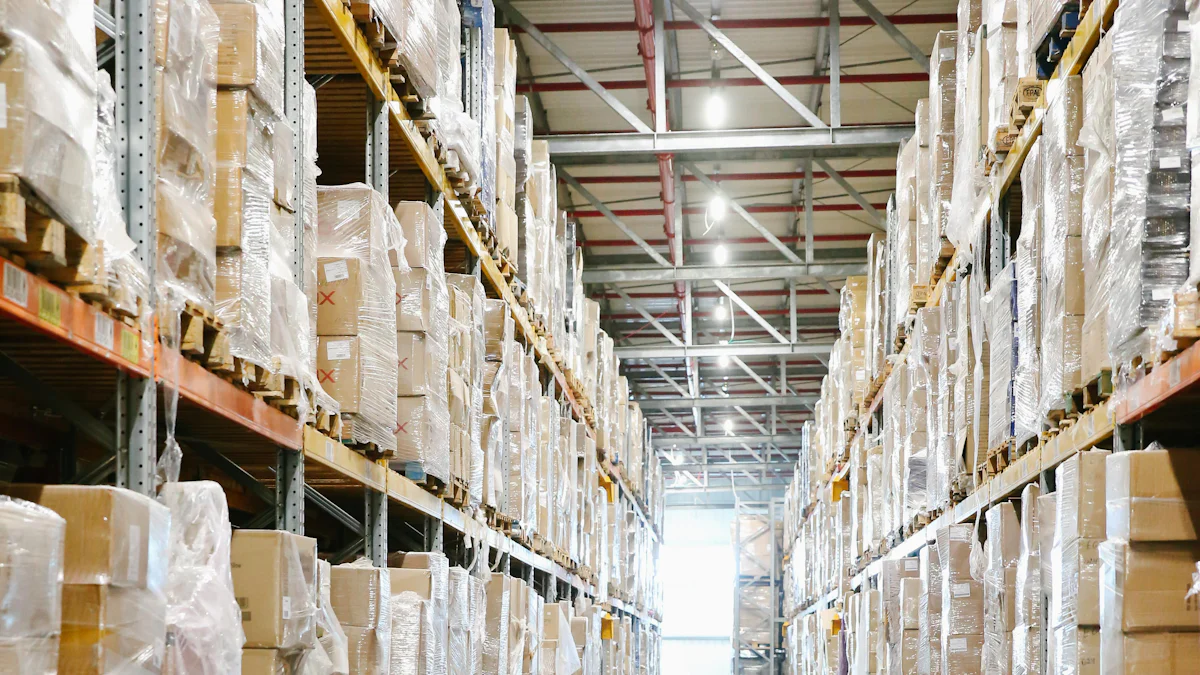How to Adapt Supply Chains for Agility and Resilience in Uncertain Times

Supply chain disruptions have become a constant challenge in today’s volatile world. You face risks from geopolitical tensions, environmental threats, and rapid technological changes. Businesses like Viva Energy Group Limited and Ampol Limited have thrived by adapting to these uncertainties. Building resilience and agility in your supply chain ensures you can navigate these complexities and remain competitive.
Key Takeaways
Agile supply chains help businesses adjust fast to changes. Use live data and smart tools to boost speed and flexibility.
Strong supply chains recover better from problems. Focus on seeing the whole process, improving steps, and flexible shipping to lower risks.
Working with suppliers and partners makes supply chains stronger. Build good relationships and use tech tools to share ideas and act quickly.
The Foundations of Supply Chain Agility and Resilience

What is Supply Chain Agility?
Supply chain agility refers to your ability to adapt quickly to changes in demand, supply, or market conditions without compromising quality or cost. An agile supply chain thrives on flexibility and speed. It allows you to respond to disruptions like sudden demand spikes or supplier shortages. Agility relies on real-time data and advanced technologies to make swift decisions. For example, integrating tools like IoT and AI can help you monitor inventory levels and adjust production schedules instantly. Agility ensures you stay competitive in a fast-changing environment.
Understanding Supply Chain Resilience
Supply chain resilience focuses on your capacity to recover from disruptions and adapt to long-term structural changes. A resilient supply chain prepares for risks and minimizes their impact. Key characteristics of resilience include:
Optimized production processes to avoid glitches.
Flexible logistics networks for quick adjustments.
Robust IT systems for real-time data analysis.
By implementing these strategies, you can ensure your supply chain withstands challenges like geopolitical tensions or natural disasters. Resilience helps you maintain service levels and maximize throughput even during disruptions.
The Interplay Between Agility and Resilience in Supply Chains
Agility and resilience complement each other in supply chain management. Agility enables you to respond quickly to demand fluctuations, while resilience ensures you recover from disruptions effectively. For instance, during the COVID-19 pandemic, companies with both agility and resilience managed disruptions better. However, balancing these traits can be challenging. Enhancing agility may sometimes reduce resilience, and vice versa. To achieve harmony, you must focus on strategies that support both, such as leveraging digital tools and conducting risk assessments.
KPI | Definition | Relevance |
|---|---|---|
Measures the average time required to recover from a supply chain disruption. | A shorter MTTR indicates a more resilient supply chain, capable of quickly responding to disruptions. | |
Supply Chain Visibility | The extent to which an organization can track and monitor supply chain activities. | High visibility is crucial for anticipating disruptions and managing risks effectively. |
By understanding the synergy between agility and resilience, you can build a supply chain that not only adapts to change but also thrives in uncertainty.
Key Challenges in Achieving Supply Chain Resilience and Agility
Limited Visibility and Fragmented Data
Limited visibility remains one of the most pressing supply chain challenges. Without real-time visibility, you cannot anticipate disruptions or make informed decisions. Many manufacturers lack the technology to process real-time data effectively. For instance, 44% of manufacturers do not have systems that support real-time insights, and over half lack proper training to handle such data. Transparency has also declined, leading to issues like data mishandling and inaccurate forecasting.
Challenge | Description |
|---|---|
Lack of real-time insights | Nearly 44% of manufacturers lack a technology stack supporting real-time data, while 55% do not have training for processing such data. |
Declining transparency | Supply chain transparency has declined in 2023, leading to increased cases of data falsification or mishandling due to low visibility into different stages of the supply chain lifecycle. |
Inaccurate forecasting | Outdated practices and slow information exchange lead to demand overestimation and seasonality errors, distorting the picture for decision-makers and supply chain managers. |
Compliance and risk management | Navigating numerous regulations creates uncertainty and friction for manufacturers, complicating their ability to manage compliance and stay updated with the latest laws. |
Fragmented data systems further complicate supply chain operations. Disconnected systems prevent you from transforming information into actionable insights. This leads to inefficiencies, higher costs, and poor customer experiences. To overcome these challenges, you must invest in integrated systems that provide real-time visibility and streamline decision-making.
Resistance to Change and Legacy Systems
Resistance to change often stems from mistrust, fear of failure, or lack of training. Employees may feel unprepared to adopt new systems, especially when organizations fail to provide adequate onboarding. Poor communication and unrealistic timelines also contribute to resistance. Legacy systems add another layer of complexity. These outdated technologies limit your ability to adapt to unexpected changes, reducing both agility and resilience.
To address resistance, you should implement comprehensive training programs and communicate the benefits of change clearly. Gradual implementation and involving team leaders can also help employees adapt more easily. By modernizing legacy systems and fostering a culture of adaptability, you can build a more agile and resilient supply chain.
External Disruptions: Economic, Geopolitical, and Environmental Factors
External disruptions pose significant risks to supply chain continuity. Events like the COVID-19 pandemic, the Suez Canal obstruction, and the Russia-Ukraine war have highlighted the fragility of global supply chains. Economic disruptions, such as inflation and factory closures, further expose vulnerabilities. Geopolitical changes, including trade wars and shifting international relations, force you to rethink sourcing strategies and trade routes.
China–United States trade war: Escalating tariffs disrupted trade flows.
Covid-19 pandemic: Factory closures and transportation delays caused widespread supply chain disruptions.
Suez Canal obstruction: Blocked global trade for nearly a week.
Russia-Ukraine war: Created shortages of critical materials.
Environmental factors, like the Panama Canal drought, also disrupt supply chain operations. To mitigate these risks, you need to diversify suppliers, conduct risk assessments, and adopt flexible logistics networks. These strategies ensure continuity and reduce the impact of unexpected changes.
Strategies to Build an Agile and Resilient Supply Chain

Leveraging Digital Tools Like JUSDA ESG
Digital tools play a crucial role in enhancing supply chain agility. Platforms like JUSDA ESG integrate advanced technologies such as IoT, AI, and blockchain to provide real-time visibility and improve decision-making. These tools allow you to track shipments, forecast demand, and streamline inventory management. For example, JusLink adapts to market changes by offering predictive analytics and automation. Other tools, including cloud-based platforms and digital twins, further enhance flexibility and efficiency.
Using digital tools can significantly improve supply chain operations. According to McKinsey, visibility helps you build resilience and overcome disruptions. Deloitte highlights that visibility fosters collaboration and control, while KPMG identifies it as a key trend in modern supply chain management. By adopting these technologies, you can reduce logistics costs by 15%, optimize inventory levels by 35%, and improve service levels by 65%.
Enhancing Collaboration Across the Supply Chain
Collaboration strengthens your supply chain by improving responsiveness and reducing costs. When you work closely with suppliers and partners, you can address disruptions more effectively. Collaborative platforms and instant messaging apps enable seamless communication across the supply chain. Enhanced collaboration has been shown to reduce operational costs by 15-25% and improve on-time delivery rates by 63%.
Building strong relationships with suppliers also enhances product quality. Better inventory management and shorter lead times result in higher customer satisfaction. By fostering collaboration, you create a resilient supply chain capable of adapting to challenges.
Conducting Risk Assessments and Scenario Planning
Risk assessments help you identify and mitigate supply chain risks. Start by conducting an end-to-end evaluation to uncover vulnerabilities, such as supplier issues or transportation delays. Analyze these risks based on their likelihood and impact, then prioritize them using a risk matrix. Develop mitigation strategies like diversifying suppliers or increasing inventory levels.
Scenario planning complements risk management strategies by preparing you for potential disruptions. Define your objectives, analyze possible outcomes, and assess influencing factors. Create scenarios that describe different future states and evaluate their impact on your supply chain. Early indicators can alert you to changes, ensuring continuity and minimizing disruptions.
Real-World Examples of Agile Supply Chain Success
Several companies have successfully implemented agile supply chain strategies. Zara’s fast fashion model relies on real-time data and lean inventory to respond quickly to trends. Apple has diversified its supplier base and uses blockchain for visibility. Amazon demonstrated flexibility during the COVID-19 pandemic by adapting safety measures to maintain operations. Toyota’s just-in-time production system emphasizes collaboration, while P&G uses scenario planning to manage risks effectively.
These examples highlight the importance of agility and resilience in overcoming supply chain disruptions. By adopting similar strategies, you can build a supply chain that thrives in uncertainty.

JUSDA Solutions
To provide you with professional solutions and quotations.
Innovation and adaptability remain essential for navigating today’s dynamic supply chain landscape. Trends like artificial intelligence, circular supply chains, and cloud-based solutions are reshaping how businesses achieve resilience and agility. JUSDA and JUSDA ESG empower you with cutting-edge tools to enhance visibility, optimize inventory, and foster collaboration. Investing in future-proof strategies ensures your supply chain thrives amidst uncertainty. Start building a resilient and agile supply chain today to secure long-term success.
See Also
Stay Ready: JUSDA Strategies for Strong Supply Chains
Embracing Innovation: Adjusting to Technology in Supply Chains
JUSDA: Your Journey Towards Supply Chain Strength
Don’t Overlook Supply Chain Threats: Safeguard Your Business
